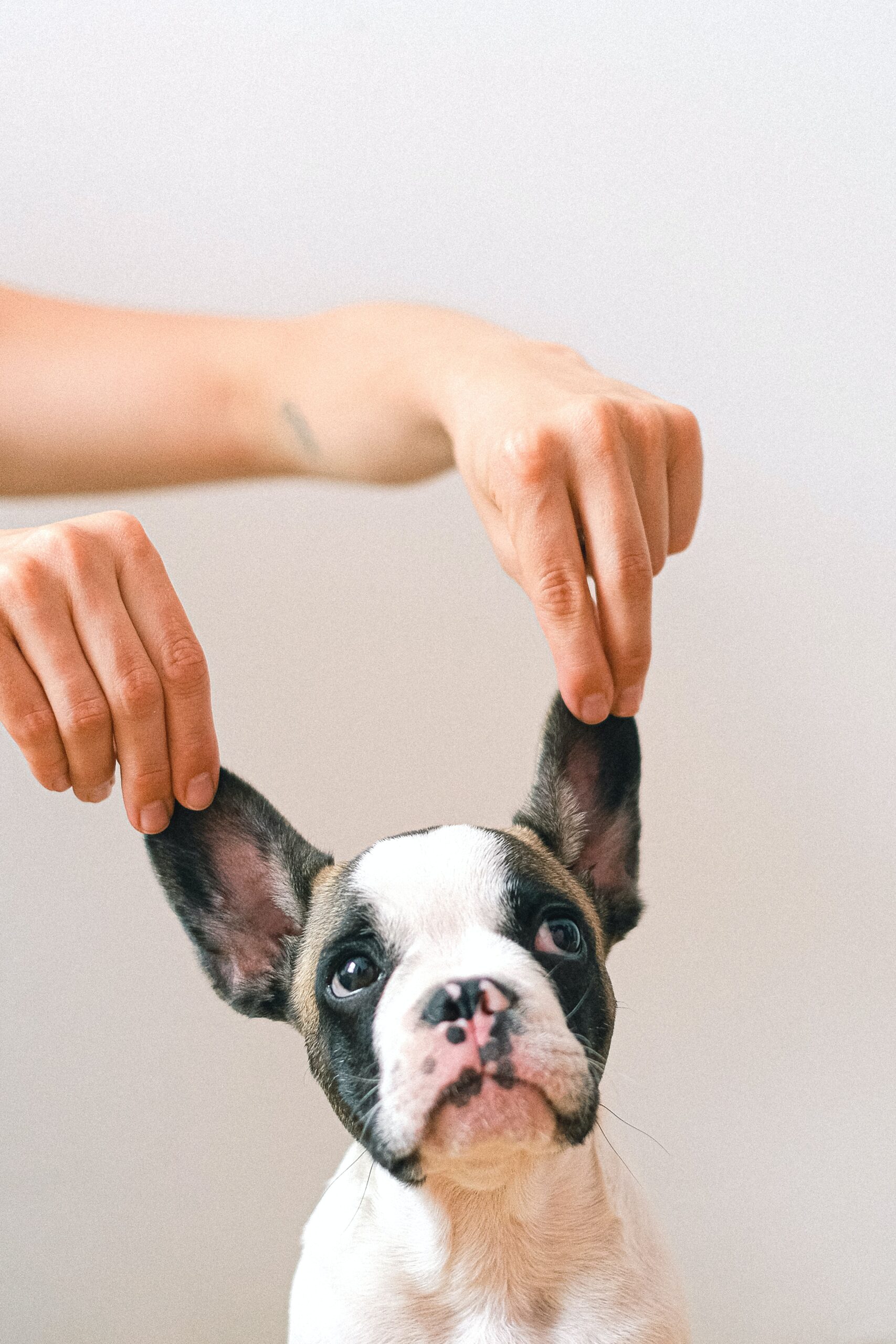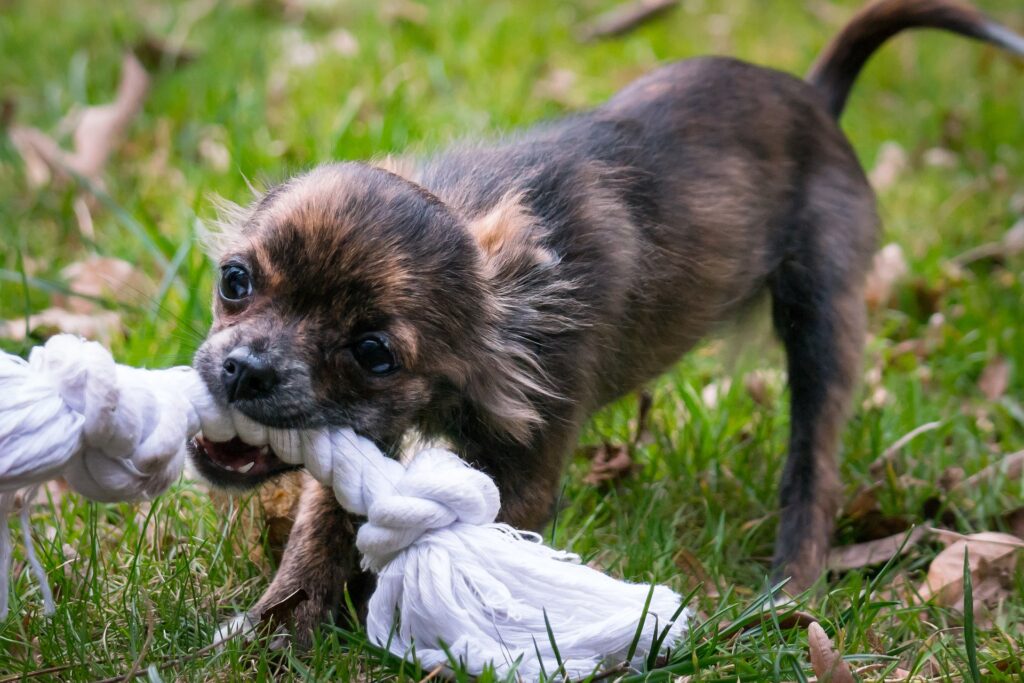
When does puppy teething start and end?
Wondering when your pup will start teething, and how long it will last? This post has everything you need to know about puppy teething – read on for more information!
Sign Up To Receive Exclusive Emails, Content, & Offers.
Also get our Free "The Airplane Game" eBook
You have subscribed successfully!
Some error occured
Please fill all the required * fields.
Your information will remain secure and will not be shared with anyone.

There’s nothing more frustrating than having your puppy constantly bite you.
Not only is it painful, but it can also be quite dangerous if they’re not properly trained. Fear not, though, because there are plenty of ways to stop your puppy from biting. In this blog post, we’ll discuss some of the most creative techniques that you can use to nip this bad habit in the bud.
So keep reading for helpful tips on how to teach your pup proper behavior!

One of the most important things to remember when training a puppy is to start with positive reinforcement.
This means rewarding them when they do something you want them to do, such as gently sniffing your fingers or nibbling on your hand. This lets them know that this behavior is acceptable and they will be more likely to repeat it in the future.
Of course, you also need to be consistent with this approach and make sure that everyone in the family is using the same methods. But if you start off on the right foot, it will make training your puppy much easier in the long run.
If your puppy starts to bite, it’s important to nip the behavior in the bud right away.
The best way to do this is to say “NO” in a firm voice and then stop interacting with them for a few minutes. This will help them to understand that biting is not acceptable behavior.
You can also gently push them away to give them a little bit of discomfort, which will help reinforce that biting is not something you want them to do. With a little patience and consistency, you should be able to train your puppy not to bite.

If you have a puppy that’s into biting everything in sight, you’re probably looking for ways to get them to stop.
The good news is, there are a few things you can do to dissuade your puppy from biting. One is to immediately provide them with a toy or chew bone as soon as they start showing interest in biting you.
This will help distract them from their urge to chew on your fingers and toes, and it’ll also give them something to sink their teeth into that’s specifically meant for puppies.
Additionally, try to avoid playing too rough with your puppy, as this can often encourage them to bite.
If they do happen to bite you, don’t punish them; instead, calmly remove yourself from the situation and provide them with an appropriate chew toy. With a little patience and training, your puppy should eventually outgrow their urge to bite everything in sight. Here are some chew toys we recommend below.
One of the most frustrating things about puppyhood is dealing with nipping and biting.
It’s important to be consistent with your commands and rewards, and remain patient while training your puppy.
If they nibble and start to gently gnaw on your hands with no pressure, award them with treats. Once they realize that biting equals no more attention or playtime, they’ll quickly learn to avoid it.
Be sure to give them plenty of chew toys to help redirect their biting instincts. With a little time and patience, your puppy will outgrow this phase and become a well-mannered dog.
If your puppy biting is getting out of control, it may be time to seek help from a professional trainer.
This is especially true if the problem persists after 3-4 months of trying to correct it yourself.
A professional trainer can help you identify the root cause of the problem and develop a training plan that will address it effectively.
They can also provide guidance on how to properly socialize your puppy and teach them bite inhibition. While seeking professional help may seem like a daunting task, it can be well worth it in the long run.
Not only will you be able to resolve the puppy biting issue, but you’ll also have peace of mind knowing that your puppy is learning from a certified professional.
So, those are our top five tips for training your puppy not to bite. It’s definitely a process that takes time and patience, but is well worth it in the end. If you have any questions or run into any problems, be sure to let me know in the comments below or shoot us an email. And don’t forget to follow us on Instagram @My_dogluvs_me for more helpful tips!

Wondering when your pup will start teething, and how long it will last? This post has everything you need to know about puppy teething – read on for more information!
In a surprising turn of events, some PetSmart employees in Colorado have found themselves embroiled in a lawsuit, alleging deceptive practices linked to their grooming school program. This controversy has not only gripped the local community but has also drawn the attention of pet lovers and legal experts nationwide. Let’s delve into the details of this lawsuit and explore the broader implications for the pet care industry.
PetSmart, a popular destination for pet owners seeking grooming services for their furry friends, boasts a grooming school designed to train its employees in pet grooming skills. However, the lawsuit claims that this initiative is not all it seems. According to the plaintiffs, the grooming school program, rather than being an educational opportunity, allegedly subjected participants to exploitative conditions.
These accusations highlight a potential disconnect between the promises made to employees and the reality of their experiences. This discrepancy forms the crux of the lawsuit, painting a picture of a program that might prioritize profit over participants’ welfare.
Numerous employees have come forward to share their experiences from the grooming school, painting a vivid picture that substantiates the claims made in the lawsuit.
The heart of the controversy lies in the nature of the training. Many employees felt misled, pointing out how the training sessions appeared more like unpaid labor than skill-building workshops. As one former participant noted, “We were doing all the tasks of a regular groomer but without adequate compensation or training.”
Several employees reported health and safety issues during their time in the grooming program. From inadequate protective equipment to handling of aggressive animals without proper guidance, these conditions raised red flags about the safety protocols within the training school. One employee recounted, “There were times I felt my safety, and the safety of the pets, was compromised due to poor working conditions.”
So far, PetSmart has maintained that their grooming school program is essential for providing high-quality grooming services and that it adheres to industry standards. In a statement, the company stressed their commitment to employee development and addressed the lawsuit allegations as “unfounded.”
However, the company has also expressed a willingness to review the program and make necessary changes if deemed appropriate. This indicates that, regardless of the lawsuit’s outcome, there is potential for improvements, provided employee grievances are taken seriously.
This lawsuit isn’t just about a single company’s internal practices. The case opens up a larger conversation about labor practices within the pet care industry at large, particularly in training programs that aim to upskill the workforce.
As the demand for pet grooming services continues to grow, ensuring ethical practices in training programs is becoming essential. Companies must strive to align their training programs with employee expectations, offering genuine opportunities for skill development without exploitation.
Pet care is inherently intertwined with safety for both animal and groomer. This lawsuit brings to light the importance of robust safety standards that protect all parties involved. The careful evaluation of safety protocols within training environments could become more of a focus across the industry.
With this lawsuit gaining public attention, regulatory bodies might feel increased pressure to examine industry practices more closely. This could result in new regulations that enforce better standards of employment and training within pet grooming and broader pet care services.
While the outcome of the lawsuit remains to be determined, its ripple effects have already begun to be felt. Whether in a court of law or the court of public opinion, how companies respond to such allegations will shape their brand perception and operational strategies.
Should the plaintiffs succeed, it may prompt:
The case also serves as a wake-up call to potential employees to thoroughly research and question training programs before participation.
The Colorado PetSmart grooming school lawsuit is more than just an individual company’s issue. It is a reflection of ongoing challenges within the industry regarding worker welfare, transparency, and safety. As the case unfolds, it will undoubtedly serve as a critical benchmark, influencing how such programs are structured and valued in the future. For pet care professionals and companies alike, this case highlights the crucial balance between profitable business practices and ethical responsibilities to employees and customers.

How To Potty Train A Puppy Fast – The Best Way! So, you’ve just brought home a new puppy and
The internet has a unique way of delivering joy through the side-splitting antics of pets. Among these cherished moments comes one featuring a Chihuahua puppy whose exaggerated reaction to its first taste of strawberries is fast becoming a viral sensation. The delightful video clip of this tiny dog engaging with a strawberry for the first time has captivated viewers, evoking laughter and heartwarming smiles across various social media platforms.
It’s not every day you see a video of a puppy becoming a social media star **overnight**. The Chihuahua puppy with its big eyes and even bigger personality has garnered thousands of views and likes, quickly turning into an online sweetheart. Here’s what makes this video so captivating:
There’s no denying that pets bring joy, but why do such exaggerated reactions particularly resonate with viewers? A mix of cuteness and relatability might just be the reason.
Many pet owners can relate to seeing their beloved companions experience new things. Whether it’s trying a new food, seeing themselves in the mirror, or meeting new friends—pet reactions mirror human experiences.
Cute animals are a steadfast anchors for internet content. Here are some reasons why the Chihuahua’s reaction outshines others on the cuteness scale:
Though the online community is captivated by the Chihuahua’s hilarious reaction, many pet owners might find themselves wondering: Are strawberries safe for dogs? Let’s delve into the health benefits of strawberries for our furry friends.
Strawberries are generally safe for dogs when given in moderation. They are an excellent source of vital nutrients that can benefit canine health in numerous ways:
When introducing strawberries to your dog’s diet, take necessary precautions:
The overwhelming popularity of pet videos during the digital age isn’t a coincidence. There are several reasons why pet videos dominate:
Humans have a profound emotional connection to animals. Videos capturing animals being curious, funny, or just their nature trigger empathy, making us feel connected to them.
In a fast-paced world filled with stress and commitments, pet videos offer a much-needed respite:
The Chihuahua puppy’s hilarious strawberry reaction is a gleaming example of the simple joys pets bring into our lives daily. As we watch this small dog navigate its first strawberry experience with exaggerated flair, we are reminded of the pure, carefree nature that animals possess and the countless ways that they enrich and brighten our world. Whether you’re a pet owner or an animal lover, you can’t help but chuckle at this instantly heartwarming video, further solidifying pets as the undisputed kings and queens of viral content on the internet.
